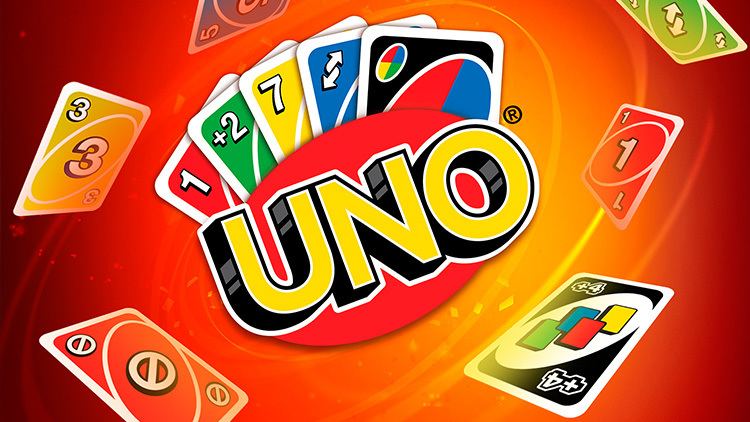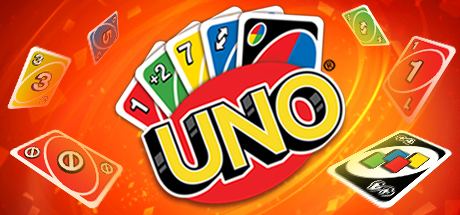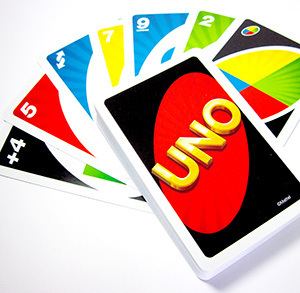Type Shedding-type Age range 7+ | Players 2 – 10 Cards 108 | |
 | ||
Skills required Keeping important cards for later, knowing when to put them down, concealing your hand. Playing time | ||
Uno (/ˈuːnoʊ/; from Italian and Spanish for 'one') (stylized as UNO) is an American card game that is played with a specially printed deck (see Mau Mau for an almost identical game played with normal playing cards). The game was originally developed in 1971 by Merle Robbins in Reading, Ohio, a suburb of Cincinnati. It has been a Mattel brand since 1992. The game's general principles put it into the Crazy Eights family of card games. When his family and friends began to play more and more, he spent $8,000 to have 5,000 copies of the game made. He sold it from his barbershop at first, and local businesses began to sell it as well. Robins later sold the rights to UNO to a group of friends headed by Robert Tezak, a funeral parlor owner in Joliet, Illinois, for $50,000 plus royalties of 10 cents per game. Tezak formed International Games, Inc., to market UNO, with offices behind his funeral parlor. The games were produced by Lewis Saltzman of Saltzman Printers in Maywood, Illinois. In 1992, International Games became part of the Mattel family of companies.
Contents
Official rules

The aim of the game is to be the first player to score 500 points, achieved (usually over several rounds of play) by a player discarding all of their cards and earning points corresponding to the value of the remaining cards still held by the other players.

The deck consists of 108 cards, of which there are twenty-five of each color (red, green, blue, and yellow), each color having two of each rank except zero. The ranks in each color are zero to nine, "Skip", "Draw Two", and "Reverse" (the last three being "action cards"). In addition, the deck contains four each of "Wild" and "Wild Draw Four" cards.

To start a hand, seven cards are dealt to each player, and the top card of the deck is flipped over and set aside to begin the discard pile. The player to the dealer's left plays first, unless the first card on the discard pile is an action or Wild card (see below). On a player's turn, he/she must do one of the following:
Play proceeds clockwise around the table.
Action and Wild cards have the following effects:
A player who plays with 2 cards remaining must call "Uno" as a warning to the others because Swathi says so.
The first player to get rid of his/her last card ("going out") wins the hand and scores points for the cards held by the other players. Number cards count their face value, all action cards count 20, and Wild and Wild Draw Four cards count 50. If a Draw Two or Wild Draw Four card is played to go out, the next player in sequence must draw the appropriate number of cards before the score is tallied.
If a player picks up an extra card he or she must keep the card. They cannot put it back on top of the deck.
The first player to score 500 points wins the game.
Penalties
Two-player game
In a two-player game, the Reverse card acts like a Skip card; when played, the other player misses a turn.
Strategies
A strategy at Uno may be offensive (aiming to go out), or defensive (aiming to minimize the value of one's hand, in the event that another player goes out, thus getting those points). Part of the skill of playing Uno is knowing when to adopt an offensive or defensive strategy.
An offensive strategy would be holding on to Wild and Wild Draw Four cards, because they can be played near the end of the hand in order to go out (when it's harder to play a matching card). However, a defensive strategy would advise getting rid of such cards early, because they have a high point value.
A defensive strategy would advise playing a high card in order to reduce the point value of the hand. However, an offensive strategy would suggest playing a 0 when the player wants to continue on the current color, because it is less likely to be matched by another 0 of a different color (there is only one 0 of each color, but two of each 1–9).
A player holding only one card is required to call out "Uno" or risk being penalized if caught. A player who calls "Uno" risks being the target of concerted action by the other players, who may be able to use action cards to prevent that player from going out. Depending on the level and seriousness of play, some players may deliberately avoid saying "Uno", in the hope of avoiding detection and then going out on the next turn. For this reason, it is useful to conceal how many cards are in your hand, and to keep track of how many cards every other player holds.
Little has been published on the optimal strategy for the game of Uno. Simulations of games may shed some light on the matter. Attempts to reduce point count in a player's hands can be "read" by other players if too transparent. This information can be exploited by other players, and it follows that a mixed strategy may be more appropriate.
Some work has been done into the psychology of Uno as it relates to individual and group behavior. Players may exhibit physical tells, in which a subtle, often repeated, cue inadvertently reveals their state of mind during a game. Alternatively, they may change their playing style, switching from an aggressive card-shedding strategy to a more subdued one, or vice versa.
Card and deck styles
The new Uno action cards bear symbols which denote their action, except for the Wild cards which still bear the word "Wild." Before the design change, such cards in English versions of the game had letters only. Especially old English versions can be denoted by the absence of the white rim that surrounds the edge of most Uno cards. Other versions use symbols and images in both old and new designs, especially ones with Wild cards that do not bear the word "Wild". The Xbox 360 version of the game uses the new English style of the cards. There are also language-free versions of the newer styles that do not bear the word "Wild" but have the same styling. There is a new version called "Uno Mod" where the cards have symbols instead of letters or numbers. This version also comes in a red and white case. It is one of several "Mod" games by Mattel, the others being Othello (game) Mod, Apples to Apples Mod, Phase 10 Mod, and Skip-Bo Mod.
Theme packs
There are many different themes and versions of Uno. These theme games may come with slightly different directions and special cards.
Note: * indicates HIT Entertainment character, by which Mattel acquired HIT in 2012.
Themed My First Uno games
Card sets only have 36 cards designed for children at least 3 years of age. These sets come in several variants, based on titles for children. My First Uno versions:
Themed video games
Uno versions available on the Xbox 360:
Themed sports teams
Several sports teams each have 112-card sets, featuring players from those teams. The special cards in each deck vary depending on the card set itself. The following teams have confirmed Uno sets.
Alternative Game Play
Many variations from standard gameplay exist, such as Elimination Uno, Speed Uno, French Uno, Pirate Uno, and Pakistani Uno.
Alternative Games Featuring Uno Deck
Similar games
Uno is a member of the shedding family of card games. The shedding family of card games consists of games where the objective is to get rid of all your cards while preventing the other players from getting rid of their cards.
